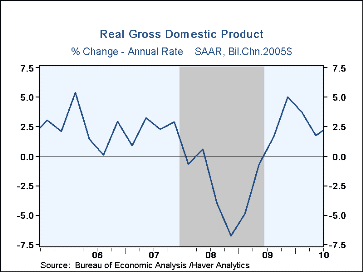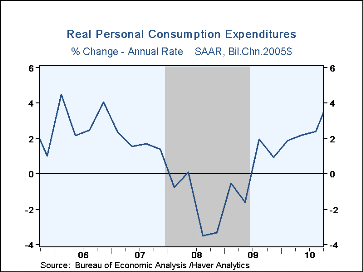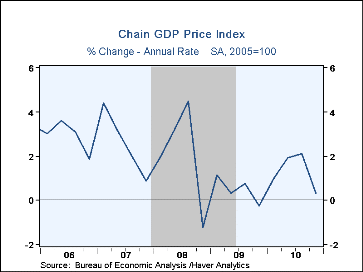 Global| Jan 28 2011
Global| Jan 28 2011U.S. GDP Growth Strengthens
by:Tom Moeller
|in:Economy in Brief
Summary
Real GDP increased 3.2% (SAAR) last quarter. Though the gain fell short of Consensus expectations for a 3.6% increase, it was the strongest since Q1 2010. For the full year, real GDP rose a moderate 2.9% and recouped the 2.6% lost [...]
Real GDP increased 3.2% (SAAR) last quarter. Though the gain fell short of Consensus expectations for a 3.6% increase, it was the strongest since Q1 2010. For the full year, real GDP rose a moderate 2.9% and recouped the 2.6% lost during 2009.
Powering last quarter's increase in total output was a 7.1% increase in final sales. That was the strongest, by a sliver, since Q3 1983 (no typo). The jump was fueled by a positive foreign trade effect of 3.4 percentage points. Exports rose at an 8.5% rate (8.9% y/y) while imports fell 13.6% (+10.6% y/y). It reversed most of the Q3 increase. Inventory decumulation offset the add from foreign trade. Lower inventories subtracted 3.4 percentage points from Q4 growth, the most since Q1 1988.
Domestic final demand growth improved during Q4. The 3.4% gain (AR) pulled the annual increase up to a moderate 1.9%, the most since 2006. Personal consumption grew at a firmed 4.4% rate with a jump in autos but growth in business investment eased to 4.4%, its weakest of the economic recovery. Residential investment grew at a moderate 3.4% rate. Nevertheless, the moderated 3.0% full-year decline in investment was the fifth drop in as many years. Government spending slipped at a 0.6% rate led by a 0.9% decline in state & local which fell 1.3% for the full year due to lower tax receipts. Federal spending slipped (+4.8%) for the first down quarter since Q1 2009.
Price inflation as measured by the chained GDP price index rose a modest 0.3%. The personal consumption chain price index rose 1.8% (1.2% y/y). The price index for fixed business investment rose by 0.8% (-0.3% y/y) but the residential investment price index rose at a 2.1% rate (-0.2% y/y). That compares to a 3.4% decline during all of last year. The GDP figures are available in Haver's USECON and USNA databases and the expectations number is in MMSAMER.
The most recent Livingston Survey of economic forecasters from the Federal Reserve Bank of Philadelphia can be found here.
| Chained 2005 $, % AR | Q4'10 (Adv.) |
Q3 10 |
Q2 10 |
Q4 Y/Y |
2010 | 2009 | 2008 |
|---|---|---|---|---|---|---|---|
| GDP | 3.2 | 2.6 | 1.7 | 2.8 | 2.9 | -2.6 | -0.0 |
| Inventory Effect | -3.7 | 1.6 | 0.8 | 0.3 | 1.5 | -0.5 | -0.5 |
| Final Sales | 7.1 | 0.9 | 0.9 | 2.5 | 1.4 | -2.1 | 0.5 |
| Foreign Trade Effect | 3.4 | -1.7 | -3.5 | -0.4 | -0.5 | 1.0 | -1.1 |
| Domestic Final Demand | 3.4 | 2.6 | 4.3 | 2.9 | 1.9 | -3.1 | -0.6 |
| Demand Components | |||||||
| Personal Consumption | 4.4 | 2.4 | 2.2 | 2.7 | 1.8 | -1.2 | -0.3 |
| Business Fixed Investment | 4.4 | 10.0 | 17.2 | 9.8 | 5.5 | -17.1 | 0.3 |
| Residential Investment | 3.4 | -27.3 | 25.6 | -4.6 | -3.0 | -22.9 | -24.0 |
| Government Spending | -0.6 | 3.9 | 3.9 | 1.4 | 1.1 | 1.6 | 2.8 |
| Prices | |||||||
| Chained GDP Price Index | 0.3 | 2.1 | 1.9 | 1.3 | 1.0 | 0.9 | 2.2 |
Tom Moeller
AuthorMore in Author Profile »Prior to joining Haver Analytics in 2000, Mr. Moeller worked as the Economist at Chancellor Capital Management from 1985 to 1999. There, he developed comprehensive economic forecasts and interpreted economic data for equity and fixed income portfolio managers. Also at Chancellor, Mr. Moeller worked as an equity analyst and was responsible for researching and rating companies in the economically sensitive automobile and housing industries for investment in Chancellor’s equity portfolio. Prior to joining Chancellor, Mr. Moeller was an Economist at Citibank from 1979 to 1984. He also analyzed pricing behavior in the metals industry for the Council on Wage and Price Stability in Washington, D.C. In 1999, Mr. Moeller received the award for most accurate forecast from the Forecasters' Club of New York. From 1990 to 1992 he was President of the New York Association for Business Economists. Mr. Moeller earned an M.B.A. in Finance from Fordham University, where he graduated in 1987. He holds a Bachelor of Arts in Economics from George Washington University.










